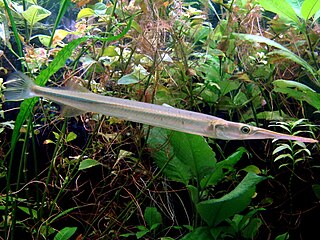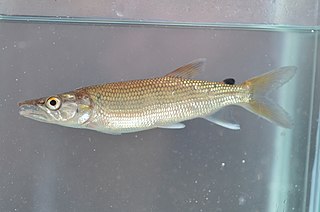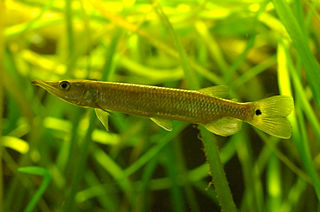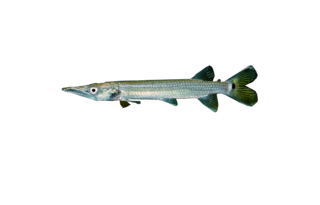The American pickerels are two subspecies of Esox americanus, a medium-sized species of North American freshwater predatory fish belonging to the pike family :

The muskellunge, often shortened to muskie,musky, ski, or lunge, is a species of large freshwater predatory fish native to North America. It is the largest member of the pike family, Esocidae.

Characidae, the characids or characins is a family of freshwater subtropical and tropical fish, belonging to the order Characiformes. The name "characins" is the historical one, but scientists today tend to prefer "characids" to reflect their status as a by and large monophyletic group at family rank. To arrive there, this family has undergone much systematic and taxonomic change. Among those fishes that remain in the Characidae for the time being are the tetras, comprising the very similar genera Hemigrammus and Hyphessobrycon, as well as a few related forms such as the cave and neon tetras. Fish of this family are important as food and also include popular aquarium fish species.

The northern pike is a species of carnivorous fish of the genus Esox (pikes). They are commonly found in moderately salty and fresh waters of the Northern Hemisphere. They are known simply as a pike in Great Britain, Ireland, most of Eastern Europe, Canada and the U.S.

Crappies are two species of North American freshwater fish of the genus Pomoxis in the family Centrarchidae (sunfishes). Both species of crappies are popular game fish among recreational anglers.

The Osmeriformes are an order of ray-finned fish that includes the true or freshwater smelts and allies, such as the galaxiids and noodlefishes; they are also collectively called osmeriforms. They belong to the teleost superorder Protacanthopterygii, which also includes pike and salmon, among others. The order's name means "smelt-shaped", from Osmerus + the standard fish order suffix "-formes". It ultimately derives from Ancient Greek osmé + Latin forma, the former in reference to the characteristic aroma of the flesh of Osmerus.

The Amazon basin is the part of South America drained by the Amazon River and its tributaries. The Amazon drainage basin covers an area of about 7,000,000 km2 (2,700,000 sq mi), or about 35.5 percent of the South American continent. It is located in the countries of Bolivia, Brazil, Colombia, Ecuador, Guyana, Peru, Suriname, and Venezuela, as well as the territory of French Guiana.

The freshwater hatchetfish are a family, Gasteropelecidae, of ray-finned fish from South and Central America. The common hatchetfish is the most popular member among fish keeping hobbyists. The family includes three genera: Carnegiella, Gasteropelecus, and Thoracocharax.

The chain pickerel is a species of freshwater fish in the pike family of order Esociformes. The chain pickerel and the American pickerel belong to the Esox genus of pike.

The rock bass, also known as the rock perch, goggle-eye, red eye, and black perch, is a freshwater fish native to east-central North America. This red-eyed fish is a species of freshwater fish in the sunfish family (Centrarchidae) of order Perciformes and can be distinguished from other similar species by the six spines in the anal fin.

Eleotridae is a family of fish commonly known as sleeper gobies, with about 34 genera and 180 species. Most species are found in the tropical Indo-Pacific region, but there are also species in subtropical and temperate regions, warmer parts of the Americas and near the Atlantic coast in Africa. While many eleotrids pass through a planktonic stage in the sea and some spend their entire lives in the sea; as adults, the majority live in freshwater streams and brackish water. One of its genera, Caecieleotris, is troglobitic. They are especially important as predators in the freshwater stream ecosystems on oceanic islands such as New Zealand and Hawaii that otherwise lack the predatory fish families typical of nearby continents, such as catfish. Anatomically, they are similar to the gobies (Gobiidae), though unlike the majority of gobies, they do not have a pelvic sucker.

Xenentodon cancila, the freshwater garfish, is a species of needlefish found in freshwater and brackish habitats in South and Southeast Asia.

The speckled longfin eel, Australian long-finned eel or marbled eel is one of 15 species of eel in the family Anguillidae. It has a long snake-like cylindrical body with its dorsal, tail and anal fins joined to form one long fin. It usually has a brownish green or olive green back and sides with small darker spots or blotches all over its body. Its underside is paler. It has a small gill opening on each side of its wide head, with thick lips. It is Australia's largest freshwater eel, and the female usually grows much larger than the male. It is also known as the spotted eel.

Hepsetus is a genus of African fishes, the African pikes or African pike characins, in the order Characiformes. It is the sole genus in the family Hepsetidae. It was long believed that only a single widespread species existed, H. odoe, but studies in 2011–2013 have shown that this species is restricted to parts of West and Central Africa. The well-known species of southern Africa, including Kafue River, is Hepsetus cuvieri. These predatory fish reach up to 44 cm (17 in) in length.

Eels are ray-finned fish belonging to the order Anguilliformes, which consists of eight suborders, 20 families, 164 genera, and about 1000 species. Eels undergo considerable development from the early larval stage to the eventual adult stage and are usually predators.

Ctenolucius is a genus of pike-characins found in southern Central America (Panama) and northwestern South America. The currently described species in this genus are:

Nannostomus espei,, commonly known as Espe's pencilfish or barred pencilfish, is a freshwater species of fish belonging to the characin family Lebiasinidae. It was first described in 1956 by Herman Meinken from the Mazaruni River system in Guyana and to date this is its only known location. It is notable amongst the genus in that the dominant body pattern consists of five broad, comma-like patches instead of the more normal horizontal stripes seen in the rest of the genus. This pattern of patches is assumed by other species at night, but only N. espei displays the pattern permanently and in daylight.

Ctenolucius hujeta, also known as silver gar, rocket gar, hujeta gar and freshwater barracuda, is a slender, medium-sized freshwater fish found in Venezuela and Colombia, where it is known as "agujeta"; Spanish for "shoelace".

Boulengerella cuiveri, commonly known as the bicuda, is a species of pike-characin in the family Ctenoluciidae.

The Luciopercinae is a subfamily of ray-finned fish, classified within the family Percidae, the subfamily includes the pike-perches and zingels. The pike-perches of the genus Sander have an Holarctic distribution while the zingels of the tribe Romanichthyini are found in Europe. They are largely freshwater species but some can be found in brackish water.



















